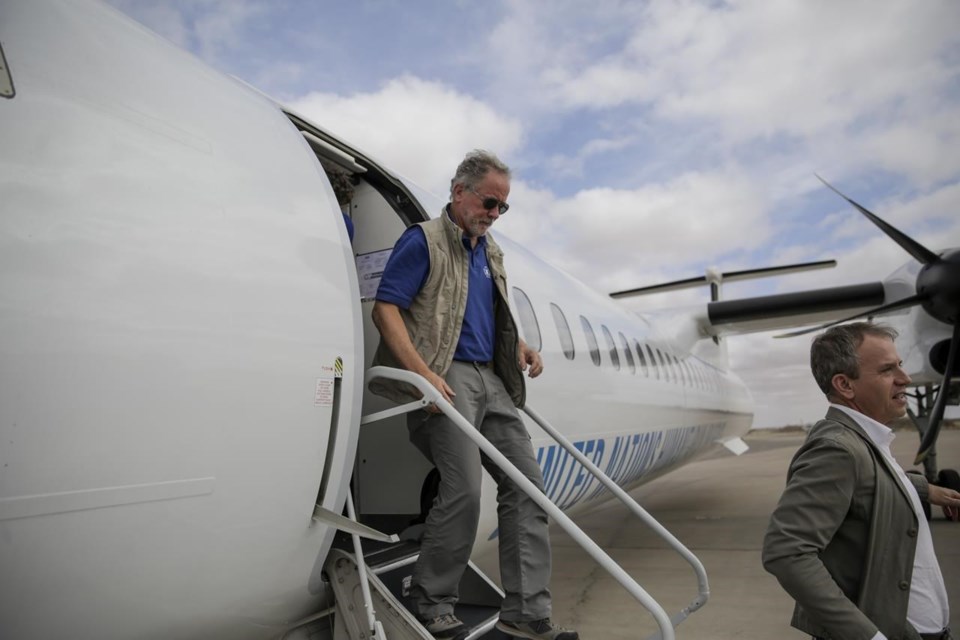BULLA HAGAR, Kenya (AP) ŌĆö is stepping up to buy about 150,000 metric tons of grain from Ukraine in the next few weeks for an upcoming shipment of food aid from ports no longer blockaded by war, the World Food Program chief has told The Associated Press.
The final destinations for are not confirmed and discussions continue, David Beasley said. But the planned shipment, one of several the U.N. agency that fights hunger is pursuing, is more than six times the amount of grain that the first WFP-arranged ship from Ukraine is now carrying toward people in the Horn of Africa at risk of starvation.
Beasley spoke Friday from northern Kenya, which is deep in a drought that is withering the Horn of Africa region. He sat under a thorn tree among local women who told the AP that the last time it rained was in 2019.
Their bone-dry communities face yet another failed rainy season within weeks that could tip parts of the region, especially , into famine. Already, thousands of people have died. The World Food Program says 22 million people are hungry.
ŌĆ£I think thereŌĆÖs a high probability weŌĆÖll have a declaration of famineŌĆØ in the coming weeks, Beasley said.
He called the situation facing the Horn of Africa a ŌĆ£perfect storm on top of a perfect storm, a tsunami on top of a tsunamiŌĆØ as the drought-prone region struggles to cope amid high food and fuel prices driven partly by the war in Ukraine.
The keenly awaited first aid ship from Ukraine is carrying 23,000 metric tons of grain, enough to feed 1.5 million people on full rations for a month, Beasley said. It is expected to dock in Djibouti on Aug. 26 or 27, and the wheat is supposed to be shipped overland to northern Ethiopia, where millions of people in the Tigray, Afar and Amhara regions have faced not only drought but .
Ukraine was the source of half the grain that WFP bought last year to feed 130 million hungry people. Russia and Ukraine signed last month to enable exports of Ukrainian grain for the first time since RussiaŌĆÖs invasion in February.
But the slow reopening of Ukraine's ports and the cautious movement of cargo ships across the mined Black Sea won't solve the global food security crisis, Beasley said. He warned that richer countries must do much more to keep grain and other assistance flowing to the hungriest parts of the world, and he named names.
ŌĆ£With oil profits being so high right now ŌĆö record-breaking profits, billions of dollars every week ŌĆö ... the Gulf states need to help, need to step up and do it now,ŌĆØ Beasley said. ŌĆ£ItŌĆÖs inexcusable not to. Particularly since these are their neighbors, these are their brothers, their family.ŌĆØ
He asserted the World Food Program could save ŌĆ£millions of livesŌĆØ with just one day of Gulf countriesŌĆÖ oil profits.
China needs to help as well, Beasley said.
ŌĆ£ChinaŌĆÖs the second-largest economy in the world, and we get diddly-squat from China,ŌĆØ or very little, he added.
Despite grain leaving Ukraine and hopes rising of global markets beginning to stabilize, the worldŌĆÖs most vulnerable people face a long, difficult recovery, the WFP chief said.
ŌĆ£Even if this drought ends, weŌĆÖre talking about a global food crisis at least for another 12 months,ŌĆØ Beasley said. ŌĆ£But in terms of the poorest of the poor, itŌĆÖs gonna take several years to come out of this."
Some of the world's poorest people without enough food are in northern Kenya, where animal carcasses are slowly stripped to the bone beneath an ungenerous sky. Millions of livestock, the source of familiesŌĆÖ wealth and nutrition, have died in the drought. Many water pumps have gone dry. More and more thousands of children are malnourished.
ŌĆ£DonŌĆÖt forget us,ŌĆØ resident Hasan Mohamud told Beasley. ŌĆ£Even the camels have disappeared. Even the donkeys have succumbed.ŌĆØ
With so many in need, aid that does arrive can disappear like a raindrop in the sand. Local women who qualified for WFP cash handouts described taking the 6,500 shillings (about $54) and sharing it among their neighbors ŌĆö in one case, 10 households.
ŌĆ£The most interesting thing we hear is people saying, ŌĆśWeŌĆÖre not the only ones,ŌĆÖŌĆØ WFP program officer Felix Okech told the AP. ŌĆ£'WeŌĆÖre the ones who have been selected (for handouts), but there are many more like us.' So that is very humbling to hear.ŌĆØ
In a small crowd that had gathered to listen to stories of children too weak to stand and milk gone dry, one woman at the edge of the woven plastic mat spoke up. Sahara Abdilleh, 50, said she makes perhaps 1,000 shillings ($8.30) a week from gathering firewood, scouring a landscape that gives less and less back every day. Like Beasley, she was thinking globally.
ŌĆ£Is there any country, like Afghanistan or Ukraine, that is worse off than us?ŌĆØ she asked.
___
Follow all AP stories about drought at
___
Follow all AP stories about the war in Ukraine at
Cara Anna, The Associated Press


